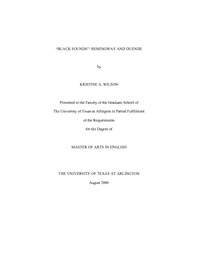
ATTENTION: The works hosted here are being migrated to a new repository that will consolidate resources, improve discoverability, and better show UTA's research impact on the global community. We will update authors as the migration progresses. Please see MavMatrix for more information.
Show simple item record
| dc.contributor.author | Wilson, Kristine A | en_US |
| dc.date.accessioned | 2007-08-23T01:56:48Z | |
| dc.date.available | 2007-08-23T01:56:48Z | |
| dc.date.issued | 2007-08-23T01:56:48Z | |
| dc.date.submitted | July 2006 | en_US |
| dc.identifier.other | DISS-1457 | en_US |
| dc.identifier.uri | http://hdl.handle.net/10106/462 | |
| dc.description.abstract | Along with his efforts to revitalize the Spanish arts in the 1920's and 1930's, Spanish poet and playwright Federico García Lorca gave an address entitled "Play and Theory of Duende" in which he claims duende as a distinctly Spanish brand of artistic inspiration and performative signature bound up with the seemingly antithetical qualities of joy and suffering that dominate the Spanish ethos.
I argue that using Lorca's concept of duende as a tool for analyzing the Spanish-themed work of Ernest Hemingway provides a new way of situating Hemingway's work within the Spanish and modernist milieux. To this end, I perform readings of The Sun Also Rises and For Whom the Bell Tolls against analyses of the bullfight and cante jondo, the two Spanish arts Lorca claims are most evocative of (or susceptible to) duende. Specifically, I focus on the aspects of liminality, primitivism, and performativity which are central both to Hemingway and these arts. | en_US |
| dc.description.sponsorship | Porter, Laurin | en_US |
| dc.language.iso | EN | en_US |
| dc.publisher | English | en_US |
| dc.title | "Black Sounds": Hemingway And Duende | en_US |
| dc.type | M.A. | en_US |
| dc.contributor.committeeChair | Porter, Laurin | en_US |
| dc.degree.department | English | en_US |
| dc.degree.discipline | English | en_US |
| dc.degree.grantor | University of Texas at Arlington | en_US |
| dc.degree.level | masters | en_US |
| dc.degree.name | M.A. | en_US |
| dc.identifier.externalLink | https://www.uta.edu/ra/real/editprofile.php?onlyview=1&pid=1208 | |
| dc.identifier.externalLinkDescription | Link to Research Profiles | |
Files in this item
- Name:
- umi-uta-1457.pdf
- Size:
- 284.3Kb
- Format:
- PDF
This item appears in the following Collection(s)
Show simple item record


